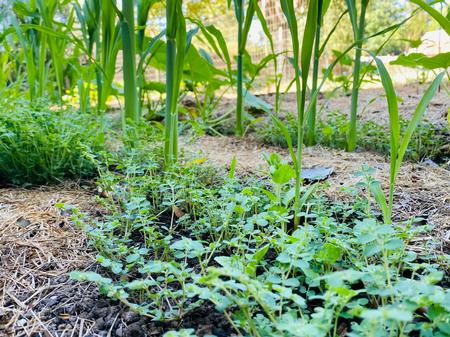Weeding

The chief methods of weed control are:
- cultivation
- mulching
- hand-weeding
Cultivation
Proper cultivation includes scraping the soil surface or very shallow penetration of the soil with a hoe or other suitable tool to cut off and remove small weeds. Use caution as deep cultivation can prune crop roots, which can cause a loss of yield.
Mulching
Mulching offers a potentially more efficient means of weed control, and it also serves to conserve soil moisture. Organic mulches, such as weathered sawdust, straw, lawn clippings, or other such materials, should be applied 2 to 4 inches deep on the soil. These mulches can be tilled under periodically to improve the condition of the soil. Some of these materials will require nitrogen during the decaying process, so apply about 2 pounds of fertilizer per 100 square feet to ensure that adequate nitrogen is available to the mulch and crops.
Weed-block fabric, newspapers, and other such materials can also serve as mulches. They serve the same functions as organic mulches, but they do not offer the soil-conditioning potential of organic mulches. Black plastic can be placed on the soil and properly anchored against wind immediately after the soil is prepared for planting. Transplants can then be set through the plastic by cutting holes just large enough for the plant to fit through.
Hand-weeding
For home gardening, pulling weeds by hand or using a weeding tool can be simple and effective, especially to remove weeds with long roots. Hoes or other long handled tools are good for surface weeds with short roots.
It is best to try and remove weeds early when they are young. Not only are smaller, young weeds easier to pull, but more importantly, you will remove them before they flower and have an opportunity to send seeds across the yard.
Don’t despair if you can’t get to the weeds while they are small, weeds can still be removed when mature. You may have to dig down a bit further to completely remove large mature weed plants. Be sure to wear gloves; some weeds are prickly or have sap that can be an irritant to the skin.
The goal of hand-weeding is to remove all of the roots so weeds will not grow back. It’s easiest to do this when the ground is damp. If you’re working in dry or compact soil, using a weed removal hand tool helps grab the root and lift it out. Weeds may have a fibrous root system or a taproot that needs to be removed.
Resources
- Want a garden pest or weed identified? Connect with your local UC Master Gardener Program!
- Pests in Gardens and Landscapes: How to manage specific weeds (UC IPM)
